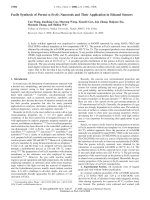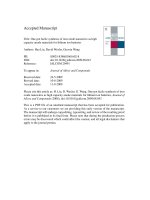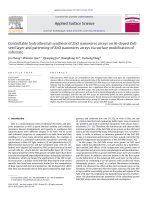facile synthesis of zno micro-nanostructures with controllable morphology and
Bạn đang xem bản rút gọn của tài liệu. Xem và tải ngay bản đầy đủ của tài liệu tại đây (161.23 KB, 5 trang )
Applied
Surface
Science
261 (2012) 759–
763
Contents
lists
available
at
SciVerse
ScienceDirect
Applied
Surface
Science
j
our
nal
ho
me
p
age:
www.elsevier.com/loc
ate/apsusc
Facile
synthesis
of
ZnO
micro-nanostructures
with
controllable
morphology
and
their
applications
in
dye-sensitized
solar
cells
Yi
Zhou
a,∗
,
Dang
Li
a
,
Xiangchao
Zhang
b
,
Jianlin
Chen
a
,
Shiying
Zhang
b
a
Department
of
Chemistry
and
Biological
Engineering,
Changsha
University
of
Science
and
Technology,
Changsha
410114,
China
b
Department
of
Science
and
Technology,
Changsha
University,
Changsha
410003,
China
a
r
t
i
c
l
e
i
n
f
o
Article
history:
Received
11
May
2012
Received
in
revised
form
31
July
2012
Accepted
31
July
2012
Available online 31 August 2012
Keywords:
ZnO
Micro-nanostructures
Urchin
Dye
sensitization
solar
cell
Photoelectric
properties
a
b
s
t
r
a
c
t
Different
morphologies
of
ZnO
micro-nanostructures
were
successfully
prepared
by
hydrothermal
method
at
relatively
mild
conditions
using
ammonia
to
adjust
the
pH
of
the
reaction
system.
The
samples
were
characterized
by
X-ray
powder
diffraction,
scanning
electron
microscopy,
optical
reflectance
spec-
tra,
and
photocurrent–voltage
curve.
The
results
demonstrated
that
the
morphologies
of
ZnO
changed
from
“wire”
to
“flower”,
“urchin”
and
“wire”
with
increase
in
the
pH
of
the
reaction
system
due
to
the
increased
concentration
of
ammonia.
The
diffused
reflectance
spectra
illustrated
that
the
reflectance
of
denser
urchin-like
ZnO
was
low
at
18%
in
the
visible
region.
When
the
as-synthesized
ZnO
micro-
nanostructures
were
used
as
the
anode
of
the
dye
sensitization
solar
cell,
the
denser
urchin-like
ZnO
exhibited
the
best
photoelectric
properties.
The
short
circuit
current
(J
sc
),
open
circuit
voltage
(V
oc
),
and
conversion
efficiency
(Á)
were
6.50
mA/cm
2
,
0.682
V,
and
1.92%,
respectively.
© 2012 Elsevier B.V. All rights reserved.
1.
Introduction
As
an
important
low-cost
semiconductor
functional
mate-
rial
with
large
band
gap
(3.37
eV)
and
large
excitation
binding
energy
(60
meV)
[1],
zinc
oxide
(ZnO)
is
recognized
as
one
of
the
most
promising
materials
for
optoelectronic
applications.
Micro-nanostructured
ZnO
has
drawn
considerable
attention
due
to
its
unique
electrical,
mechanical,
and
optical
properties,
in
addition
to
its
applications
in
numerous
fields,
such
as
solar
cells
[2],
gas
sensors
[3,4],
piezoelectric
materials
[5],
pho-
tonic
crystals
[6],
and
optoelectric
devices
[7].
Previous
studies
demonstrated
that
the
properties
of
ZnO
are
closely
related
to
the
size
and
shape
of
the
structures.
For
example,
tetra-
pod
ZnO
nanostructures
exhibit
strong
UV
emission
[8]
and
needle-like
ZnO
arrays
exhibit
strong
blue
light
emission
[9].
Thus,
studying
the
morphology
of
micro-nanostructured
ZnO
is
important.
ZnO
micro-nanostructures
have
been
synthesized
with
various
methods,
such
as
chemical
vapour
deposition
[10],
template-based
method
[11],
laser
ablation
[12],
spray
pyrolysis
technique
[13],
hydrothermal
method
[14],
and
electrodeposition
method
[15].
Researchers
have
prepared
micro-nanostructured
ZnO
with
dif-
ferent
morphologies
using
these
different
methods.
For
example,
Polsongkram
et
al.
[14]
prepared
ZnO
nanorods
by
hydrothermal
∗
Corresponding
author.
Tel.:
+86
731
85258328;
fax:
+86
731
85258328.
addresses:
,
(Y.
Zhou).
method.
Chen
et
al.
[16]
synthesized
ZnO
nanotubes
by
a
sonochemical
method
at
low
temperature.
Liu
and
Zeng
[17]
fabricated
ZnO
dandelions
by
a
modified
Kirkendall
process.
Jana
et
al.
[18]
prepared
water
lily-type
ZnO
flowers
by
a
simple
solution
method,
and
Elias
et
al.
[19]
prepared
hollow
urchin-like
ZnO
thin
films
by
electrochemical
deposition.
How-
ever,
majority
of
these
studies
are
limited
to
the
research
of
one
kind
of
morphology.
Few
studies
have
reported
on
ZnO
micro-nanostructures
with
different
morphologies
using
a
single
method.
In
the
present
study,
several
types
of
ZnO
micro-nanostructures
with
different
morphologies
and
photoelectric
properties
were
prepared
by
a
simple
hydrothermal
method
at
relatively
mild
conditions.
The
concentration
of
ammonia,
which
can
adjust
the
pH
of
the
reaction
system,
was
controlled.
Subsequently,
the
influence
of
pH
on
the
photoelectric
properties
of
the
ZnO
micro-nanostructures
was
investigated
by
studying
the
photocurrent–voltage
(I–V)
characteristics
of
the
dye-sensitized
solar
cell
(DSSC).
2.
Experimental
2.1.
Materials
All
chemicals
were
of
analytical
reagent
grade
and
used
with-
out
further
purification.
All
aqueous
solutions
were
prepared
using
double
distilled
water.
0169-4332/$
–
see
front
matter ©
2012 Elsevier B.V. All rights reserved.
/>760 Y.
Zhou
et
al.
/
Applied
Surface
Science
261 (2012) 759–
763
2.2.
Preparation
of
ZnO
film
ZnO
micro-nanostructures
were
synthesized
using
a
hydro-
thermal
method.
The
procedure
was
as
follows:
1.18
g
zinc
nitrate
hexahydrate
(Zn(NO
3
)
2
·6H
2
O)
and
0.56
g
hexamethylenetetramine
(C
6
H
12
N
4
)
were
added
to
40
mL
double
distilled
water
under
strong
magnetic
stirring
at
room
temperature
to
obtain
a
transparent
and
homogeneous
solution.
NH
3
(25%)
was
then
dropped
into
the
solu-
tion
at
60
drops/min
to
change
the
pH
from
7
to
11.
The
solution
was
kept
at
room
temperature
for
0.5
h
under
vigorous
stirring
to
obtain
the
precursor.
The
ZnO
micro-nanostructures
used
in
this
work
were
grown
on
FTO-coated
glass
substrates.
First,
the
FTO-coated
glass
substrates
were
successively
cleaned
in
an
ultrasonic
bath
with
acetone,
ethanol,
and
double
distilled
water
for
15
min
to
remove
dust
and
prevent
surface
contamination.
The
FTO-coated
glass
substrates
were
then
dipped
in
0.5
mol/L
ZnCl
2
aqueous
solution
for
5
min
at
room
temperature.
Finally,
the
substrates
were
pulled
upward
by
a
hoist
with
constant
speed,
and
then
dried
in
the
air
to
obtain
functionalized
FTO-coated
glass
substrates
[20].
The
precursor
solution
and
the
functionalized
substrates
were
transferred
to
a
Teflon-sealed
autoclave.
Then
the
reaction
was
kept
at
90
◦
C
for
9
h
to
synthesize
the
ZnO
micro-nanostructures.
After
deposition,
the
samples
were
cleaned
several
times
with
double
distilled
water
and
then
dried
in
the
air.
2.3.
Construction
of
dye-sensitized
solar
cell
The
construction
of
DSSC
has
been
reported
in
a
previous
research
[21].
2.4.
Characterization
The
samples
were
characterized
using
scanning
electron
microscopy
(SEM,
JEOL
JSM-6700F)
and
X-ray
diffraction
patterns
were
recorded
on
an
X-ray
diffraction
system
(SIEMENS
D5000).
The
diffused
reflectance
spectra
were
measured
by
an
IPCE
tester
(Solar
Cell
Scan
100,
Beijing
Zhuo
Li
Han
Guang).
The
I–V
charac-
teristics
were
measured
using
a
computer-controlled
digital
source
meter
(Keithley,
Model
2400)
under
the
illumination
of
a
Newport
solar
simulator
(AM
1.5,
100
mW/cm
2
).
3.
Results
and
discussion
3.1.
Morphology
and
structural
analyses
Fig.
1
depicts
the
SEM
images
of
micro-nanostructured
ZnO
grown
under
different
pH,
namely,
7,
8,
9,
10
and
11.
The
growth
temperature
and
time
were
90
◦
C
and
9
h,
respectively.
As
shown
in
Fig.
1,
the
morphology
of
the
as-grown
micro-nanostructured
ZnO
was
closely
related
to
the
pH
of
the
precursor
solution.
Fig.
1a
indicates
that
ZnO
nanowires
formed
on
the
substrate
when
the
applied
pH
was
7.
The
dense
ZnO
nanowires
with
hexagonal
structure
were
vertically
well-aligned
and
uniformly
distributed
on
the
substrate.
The
average
diameters
of
the
ZnO
nanowires
were
approximately
30–50
nm;
the
length–diameter
ratios
were
approximately
6–10.
The
sample
prepared
with
pH
=
8
resulted
in
the
formation
of
flower-like
ZnO
whose
petals
were
approximately
500–700
nm
in
length
and
300–400
nm
in
width
(Fig.
1b).
When
the
pH
was
increased
to
9,
urchin-like
ZnO
were
formed.
Fig.
1c
reveals
that
the
urchin-like
ZnO
was
comprised
of
nanorods,
which
had
similar
centers
and
were
approximately
5–6
m
in
length
and
300–500
nm
in
width.
Notably,
urchin-like
ZnO
also
formed
when
the
applied
pH
was
controlled
at
10
(Fig.
1d).
However,
this
urchin-like
ZnO
was
comprised
of
needle-like
ZnO
nanowires,
and
the
sizes
and
amounts
of
ZnO
nanowires
were
also
different
from
those
in
Fig.
1c.
When
the
applied
pH
was
increased
to
11,
the
urchin-like
morphologies
disappeared
and
changed
to
ZnO
nanowires
with
poor
orientations.
The
average
diameters
of
these
ZnO
nanowires
were
approximately
50–80
nm,
and
their
average
lengths
were
approximately
500–600
nm.
Fig.
1f
and
g
is
the
lower
magnification
SEM
images
of
Fig.
1c
and
d,
respectively.
The
urchin
structures
were
lined
by
a
single
layer
on
the
substrate,
and
all
the
ZnO
nanowires
were
relatively
homoge-
neous.
Fig.
1h
reveals
the
side
view
images
of
micro-nanostructured
ZnO
at
pH
=
10.
As
shown
in
Fig.
1h,
the
film
thicknesses
were
about
2
m.
Urchin-like
ZnO
micro-nanostructures
were
formed
on
FTO-
coated
glass
substrates
by
a
hydrothermal
method.
The
formation
process
can
be
expressed
as
follows
[22]:
(CH)
6
N
4
+
6H
2
O
→
6HCHO
+
NH
3
(1)
NH
3
+
H
2
O
→
NH
4
+
+
OH
−
(2)
Zn
2+
+
NH
3
→
Zn(NH
3
)
4
2+
(3)
Zn
2+
+
4OH
−
→
Zn(OH)
4
2−
(4)
Zn(NH
3
)
4
2+
+
2OH
−
→
ZnO
+
4NH
3
+
H
2
O
(5)
Zn(OH)
4
2−
→
ZnO
+
H
2
O
+
2OH
−
(6)
Based
on
the
growth
habits
of
ZnO
crystals
in
aqueous
solu-
tions,
urchin-like
ZnO
micro-nanostructures
can
be
obtained
only
when
the
pH
of
the
bulk
solution
are
controlled
at
certain
values.
When
the
pH
is
low,
the
concentrations
of
OH
−
and
NH
3
in
the
precursor
solution
are
correspondingly
low,
leading
to
the
small
amount
of
Zn(OH)
4
2−
and
Zn(NH
3
)
4
2+
,
which
are
insufficient
to
form
the
nuclei.
Therefore,
ZnO
nanowires
form
on
the
substrate
when
the
applied
pH
is
controlled
at
7
(Fig.
1a).
The
amount
of
Zn(OH)
4
2−
and
Zn(NH
3
)
4
2+
increases
with
the
pH.
When
the
pH
is
above
8,
Zn(OH)
4
2−
and
Zn(NH
3
)
4
2+
will
gather
and
decompose
to
ZnO
nuclei
at
the
beginning
of
the
reaction.
The
growth
units
of
Zn(OH)
4
2−
and
Zn(NH
3
)
4
2+
are
then
adsorbed
on
the
nuclei
due
to
intermolecular
absorption
forces,
such
as
van
der
Waals
interactions,
and
finally
grow
to
nanowires
in
all
directions
to
form
three-dimensional
urchin-like
ZnO.
The
SEM
micrographs
in
Fig.
1
reveal
that
the
morphologies
of
three-dimensional
ZnO
are
different
under
different
conditions.
As
the
pH
increases,
the
mor-
phologies
of
ZnO
change
from
“flower”
(Fig.
1b),
to
sparse
“sea
urchin”
(Fig.
1c)
and
denser
“sea
urchin”
(Fig.
1d).
The
pH
has
an
important
function
during
the
formation
of
the
ZnO
micro-
nanostructures.
This
can
be
explained
as
follows.
Ammonia
can
easily
separate
from
the
solution
when
the
pH
is
high,
which
results
in
an
increase
in
the
air
pressure
of
the
Teflon-sealed
autoclave.
This
will
influence
the
growth
of
ZnO
micro-nanostructures,
lead-
ing
to
change
in
the
morphology
of
ZnO.
The
pH
of
the
reaction
solution
increases
with
the
addition
of
ammonia.
At
the
same
time,
the
growth
units
are
more
likely
to
come
in
contact
with
the
nuclei.
This
phenomenon
can
be
propitious
for
the
formation
of
Zn(OH)
4
2−
and
Zn(NH
3
)
4
2+
,
finally
leading
to
an
increase
in
the
amount
of
nanowires
on
the
nuclei.
However,
when
the
pH
increases
to
a
certain
degree,
the
air
pressure
in
the
Teflon-sealed
autoclave
will
increase
to
a
greater
degree;
thus,
Zn(OH)
4
2−
and
Zn(NH
3
)
4
2+
are
unable
to
gather
to
form
the
initial
ZnO
nuclei.
Therefore,
the
pre-
cursor
solution
is
generated
for
the
single
and
independent
ZnO
nanowires,
hindering
them
from
forming
flower-
or
urchin-like
ZnO.
The
concentration
of
ammonia,
the
pH,
and
the
air
pressure
of
the
Teflon-sealed
autoclave
has
an
important
function
in
the
above
transformation
processes
of
ZnO
morphologies.
However,
the
specific
reaction
mechanism
requires
further
research.
Y.
Zhou
et
al.
/
Applied
Surface
Science
261 (2012) 759–
763 761
Fig.
1.
SEM
images
of
the
micro-nanostructured
ZnO
under
different
pH:
(a)
7;
(b)
8;
(c
and
f)
9;
(d
and
g)
10;
and
(e)
11.
Lower
magnification
SEM
images
(f)
and
(g).
Side
view
images
of
micro-nanostructured
ZnO
at
pH
=
10
(h).
3.2.
XRD
patterns
Fig.
2
shows
the
XRD
spectra
of
the
micro-nanostructured
ZnO
under
different
pH.
All
diffraction
peaks
can
be
indexed
to
a
hexag-
onal
wurtzite
phase
of
ZnO,
in
agreement
with
the
standard
card
(JCPDS
78-2486).
No
characteristic
peaks
of
any
impurities,
except
polycrystalline
SnO
2
(from
the
FTO
substrate),
were
detected
in
the
pattern,
confirming
that
the
obtained
products
are
pure
ZnO.
The
characteristic
peaks
were
high
in
intensity
and
narrow,
which
indicated
that
ZnO
micro-nanostructure
had
high
crystallinity.
The
intensities
of
the
diffraction
peaks
of
micro-nanostructured
ZnO
were
obviously
different,
indicating
that
the
pH
had
effect
on
the
crystallinity
of
grown
ZnO
micro-nanostructure.
3.3.
Optical
reflection
spectra
analyses
Fig.
3
shows
the
optical
reflection
spectra
of
the
micro-
nanostructured
ZnO
under
different
pH.
Fig.
3
indicates
that
the
light
scattering
of
the
ZnO
micro-nanostructure
is
closely
related
to
its
morphology.
The
surface
areas
of
denser
urchin-
like
structure,
sparse
urchin-like
structure,
vertically
well-aligned
nanowire
structure,
disorderly
nanowire
structure
and
flower-like
structure
were
350,
290,
223,
147,
96
m
2
/g,
respectively.
And
due
to
the
different
surface
areas
of
the
different
morphologies,
the
order
of
intensity
of
the
ZnO
micro-nanostructure
light
scatter-
ing
is
as
follows:
denser
urchin-like
structure
<
sparse
urchin-like
structure
<
vertically
well-aligned
nanowire
structure
<
disorderly
nanowire
structure
<
flower-like
structure.
Among
these
ZnO
micro-nanostructures,
the
reflectance
of
the
denser
urchin-like
ZnO
is
the
lowest
at
approximately
18%
in
the
visible
region.
The
reflectance
of
the
flower
structure
is
the
highest.
This
could
attribute
to
the
size
[23]
and
the
morphology
[24]
of
ZnO,
which
play
important
roles
for
controlling
the
light
scattering.
In
addition,
the
graph
indicates
that
the
entire
ultraviolet
absorption
spectrum
edge
is
approximately
380
nm,
which
is
in
agreement
with
the
direct
wide
band
gap
(3.37
eV)
of
ZnO.
3.4.
Application
of
ZnO
micro-nanostructure
in
DSSC
Fig.
4
compares
the
I–V
characteristics
of
the
DSSC
based
on
ZnO
with
different
micro-nanostructures.
The
corresponding
values
are
summarized
in
Table
1,
which
demonstrates
photoelectro-
chemical
characteristics,
such
as
current
density
at
short
circuit
(J
sc
),
voltage
at
open
circuit
(V
oc
),
fill
factor
(FF),
and
efficiency
762 Y.
Zhou
et
al.
/
Applied
Surface
Science
261 (2012) 759–
763
Fig.
2.
XRD
spectra
of
the
micro-nanostructured
ZnO
under
different
pH:
(a)
7;
(b)
11;
(c)
8;
(d)
9;
and
(e)
10.
Fig.
3.
Optical
reflection
spectra
of
the
micro-nanostructured
ZnO
under
different
pH:
(a)
8;
(b)
11;
(c)
7;
(d)
9;
and
(e)
10.
Fig.
4.
Photocurrent–voltage
characteristics
of
ZnO
with
different
micro-
nanostructure-based
DSSCs.
(a)
Denser
urchin-like
ZnO;
(b)
sparse
urchin-like
ZnO;
(c)
orderly
ZnO
nanowire;
(d)
flower-like
ZnO;
and
(e)
disorderly
ZnO
nanowire.
Table
1
Photovoltaic
parameters
of
micro-nanostructured
ZnO
with
different
micro-
nanostructures.
Film
type
J
sc
(mA/cm
2
)
V
oc
(V)
FF
(%)
Á
(%)
Orderly
ZnO
nanowire
4.48
0.598
36.7
0.98
Disorderly
ZnO
nanowire
3.13
0.526
27.3
0.45
Flower-like
ZnO
3.93
0.537
33.2
0.70
Sparse
urchin-like
ZnO
4.82
0.654
38.5
1.21
Denser
urchin-like
ZnO
6.50
0.682
43.4
1.92
of
power
conversion
(Á)
in
different
samples.
Table
1
indicates
that
the
photoelectrochemical
characteristics
of
the
DSSC-based
denser
urchin-like
ZnO
are
high,
reaching
a
maximum
value
of
1.92%.
Notably,
the
denser
urchin-like
structure
is
beneficial
for
the
transfer
of
electrolytes,
and
this
specific
structure
can
increase
the
production
of
carriers
and
photoelectric
activity
due
to
its
larger
surface
area
and
increased
activity
centers
for
absorbing
dye.
In
the
urchin-like
structure,
the
needle-like
ZnO
nanowires
have
the
same
center
extended
to
the
surroundings.
This
special
structure
can
effectively
improve
the
efficiency
of
electron
transmission,
decreases
the
transmission
path
of
charge
in
the
electrode
materi-
als
and
the
recombination
of
carriers.
As
a
result,
the
photoelectric
activity
of
ZnO
increases.
Table
1
further
shows
that
the
ZnO
nanowires
were
formed
on
the
substrate
when
the
applied
pH
was
controlled
at
7
and
11,
but
the
photoelectric
parameters
of
these
two
different
nanowires
varied
enormously.
Due
to
their
excellent
orientation,
the
ZnO
nanowires
prepared
at
pH
=
7
can
provide
an
effective
transmis-
sion
path
for
electrons,
reduce
the
recombination
of
carriers,
and
increase
the
photoelectric
activity
of
ZnO.
4.
Conclusions
Several
kinds
of
ZnO
micro-nanostructures
with
different
mor-
phologies
and
photoelectric
properties
have
been
prepared
by
a
simple
hydrothermal
method
at
relatively
mild
conditions.
The
pH
is
essential
in
the
growth
of
ZnO,
and
results
in
the
mor-
phology
of
ZnO
changing
from
“wire”
to
“flower”,
“urchin”
and
“wire”
with
the
addition
of
different
amounts
of
ammonia.
Due
to
the
different
surface
areas
of
the
various
morphologies,
the
order
of
intensity
of
the
ZnO
micro-nanostructure
light
scatter-
ing
is
as
follows:
denser
urchin-like
structure
<
sparse
urchin-like
Y.
Zhou
et
al.
/
Applied
Surface
Science
261 (2012) 759–
763 763
structure
<
vertically
well-aligned
nanowire
structure
<
disorderly
nanowire
structure
<
flower-like
structure.
Among
the
foregoing,
the
reflectivity
of
the
denser
urchin-like
structure
was
the
lowest
at
18%.
When
the
obtained
ZnO
micro-nanostructures
were
used
as
the
anode
of
the
DSSC,
the
photoelectrochemical
characteristics
of
the
DSSC
based
on
ZnO
with
different
micro-nanostructures
vary.
The
denser
urchin-like
ZnO
micro-nanostructures
display
excellent
photoelectric
properties
due
to
their
larger
surface
area,
increased
activity
centers,
and
more
effective
transmission
paths.
Acknowledgments
This
work
was
supported
by
the
National
Natural
Science
Foundation
of
China
(grant
no.
21171027).
The
authors
are
also
grateful
to
the
aid
provided
by
the
Science
and
Technology
Inno-
vative
Research
Team
in
Higher
Educational
Institutions
of
Hunan
Province.
References
[1]
J.R.
Jennings,
L.M.
Peter,
A
reappraisal
of
the
electron
diffusion
length
in
solid-
state
dye-sensitized
solar
cells,
J.
Phys.
Chem.
C
111
(2007)
16100–16104.
[2]
B.N.
Pawar,
G.
Cai,
D.
Hama,
R.S.
Mane,
T.
Ganesh,
A.
Ghule,
R.
Sharma,
K.D.
Jadhava,
S.H.
Han,
Preparation
of
transparent
and
conducting
boron-doped
ZnO
electrode
for
its
application
in
dye-sensitized
solar
cells,
Sol.
Energy
Mater.
Sol.
Cells
93
(2009)
524–527.
[3]
J.
Yi,
J.M.
Lee,
W.I.
Park,
Vertically
aligned
ZnO
nanorods
and
graphene
hybrid
architectures
for
high-sensitive
flexible
gassensors,
Sens.
Actuators
B:
Chem.
115
(2011)
264–269.
[4]
T.
Krishnakumar,
R.
Jayaprakash,
N.
Pinna,
N.
Donato,
A.
Bonavita,
G.
Micali,
G.
Neri,
CO
gas
sensing
of
ZnO
nanostructures
synthesized
by
an
assisted
microwave
wet
chemical
route,
Sens.
Actuators
B:
Chem.
143
(2009)
198–204.
[5]
W.
Water,
T.H.
Fang,
L.W.
Ji,
C.C.
Lee,
Effect
of
growth
temperature
on
photo-
luminescence
and
piezoelectric
characteristics
of
ZnO
nanowires,
Mater.
Sci.
Eng.
B
158
(2009)
75–78.
[6] H.
Wang,
K.P.
Yan,
J.
Xie,
M.
Duan,
Fabrication
of
ZnO
colloidal
photoniccrystal
by
spin-coating
method,
Mater.
Sci.
Semicond.
Process.
11
(2008)
44–47.
[7]
G.Z.
Shen,
Y.
Bando,
C.J.
Lee,
Synthesis,
Evolution
of
novel
hollow
ZnO
urchins
by
a
simple
thermal
evaporation
process,
J.
Phys.
Chem.
B
109
(2005)
10578–10583.
[8]
Z.G.
Chen,
A.Z.
Ni,
F.
Li,
H.T.
Cong,
H.M.
Cheng,
G.Q.
Lu,
Synthesis
and
photo-
luminescence
of
tetrapod
ZnO
nanostructures,
Chem.
Phys.
Lett.
434
(2007)
301–305.
[9]
T.G.
You,
J.F.
Yan,
Z.Y.
Zhang,
J.
Li,
J.X.
Tian,
J.N.
Yun,
W.
Zhao,
Fabrication
and
optical
properties
of
needle-like
ZnO
array
by
a
simple
hydrothermal
process,
Mater.
Lett.
66
(2012)
246–249.
[10]
Q.J.
Feng,
L.Z.
Hu,
H.W.
Liang,
Y.
Feng,
J.
Wang,
J.C.
Sun,
J.Z.
Zhao,
M.K.
Li,
L.
Dong,
Catalyst-free
growth
of
well-aligned
arsenic-doped
ZnO
nanowires
by
chemicalvapordeposition
method,
Appl.
Surf.
Sci.
257
(2010)
1084–1087.
[11] J.
Singh,
S.S.
Patil,
M.A.
More,
D.S.
Joag,
R.S.
Tiwari,
O.N.
Srivastava,
Formation
of
aligned
ZnO
nanorods
on
self-grown
ZnO
template
and
its
enhanced
field
emission
characteristics,
Appl.
Surf.
Sci.
256
(2010)
6157–6163.
[12]
X.F.
Duan,
C.M.
Lieber,
General
synthesis
of
compound
semiconductor
nanowires,
Adv.
Mater.
12
(2000)
298–302.
[13]
S.D.
Shinde,
G.E.
Patil,
D.D.
Kajale,
V.B.
Gaikwad,
G.H.
Jain,
Synthesis
of
ZnO
nanorods
by
spraypyrolysis
for
H
2
S
gas
sensor,
J.
Alloys
Compd.
528
(2012)
109–114.
[14] D.
Polsongkrama,
P.
Chamninok,
S.
Pukird,
L.
Chow,
O.
Lupan,
G.
Chai,
H.
Khallaf,
S.
Park,
A.
Schulte,
Effect
of
synthesis
conditions
on
the
growth
of
ZnO
nanorods
via
hydrothermal
method,
Physica
B
403
(2008)
3713–3717.
[15] R.
Chander,
A.K.
Raychaudhuri,
Electrodeposition
of
aligned
arrays
of
ZnO
nanorods
in
aqueous
solution,
Solid
State
Commun.
145
(2008)
81–85.
[16]
Y.J.
Chen,
C.L.
Zhu,
G.
Xiao,
Ethanol
sensing
characteristics
of
ambient
tempera-
ture
sonochemically
synthesized
ZnO
nanotubes,
Sens.
Actuators
B
129
(2008)
639–642.
[17]
B.
Liu,
H.C.
Zeng,
Fabrication
of
ZnO
dandelions
via
a
modified
Kirkendall
pro-
cess,
J.
Am.
Chem.
Soc.
126
(2004)
16744–16746.
[18]
A.
Jana,
N.R.
Bandyopadhyay,
P.
Sujatha
Devi,
Formation
and
assembly
of
blue
emitting
water
lily
type
ZnO
flowers,
Solid
State
Sci.
13
(2011)
1633–1637.
[19]
J.
Elias,
C.
Levy-Clement,
M.
Bechelany,
J.
Michler,
G.Y.
Wang,
Z.
Wang,
L.
Philippe,
Hollow
urchin-like
ZnO
thin
films
by
electrochemical
deposition,
Adv.
Mater.
22
(2010)
1607–1612.
[20]
C.S.
Liu,
Y.
Masuda,
Y.Y.
Wu,
O.
Takai,
A
simple
route
for
growing
thin
films
of
uniform
ZnO
nanorod
arrays
on
functionalized
Si
surfaces,
Thin
Solid
Films
503
(2006)
110–114.
[21] H.
Li,
Y.
Zhou,
C.X.
Lv,
M.M.
Dang,
Templated
synthesis
of
ordered
porous
TiO
2
films
and
their
application
in
dye-sensitized
solar
cell,
Mater.
Lett.
65
(2011)
1808–1810.
[22]
J.
Xie,
H.
Wang,
M.
Duan,
L.H.
Zhang,
Synthesis
and
photocatalysis
properties
of
ZnO
structures
with
different
morphologies
via
hydrothermal
method,
Appl.
Surf.
Sci.
257
(2011)
6358–6363.
[23]
R.
Tena-Zaera,
J.
Elias,
C.
Lévy-Clément,
ZnO
nanowire
arrays:
optical
scattering
and
sensitization
to
solar
light,
Appl.
Phys.
Lett.
93
(2008)
233119.
[24] C.
Lévy-Clément,
J.
Elias,
R.
Tena-Zaera,
ZnO/CdSe
nanowires
and
nano-
tubes:
formation,
properties
and
applications,
Phys.
Status
Solidi
C
7
(2009)
1596–1600.









